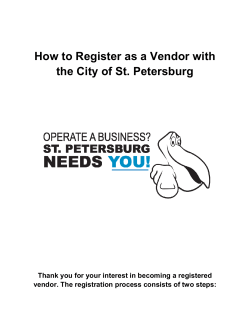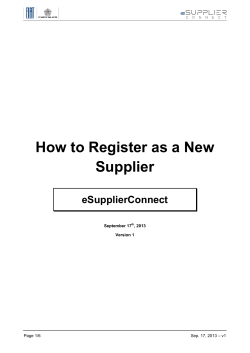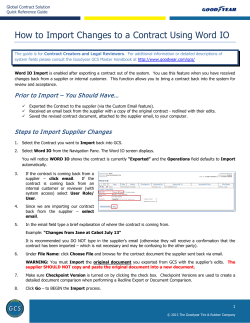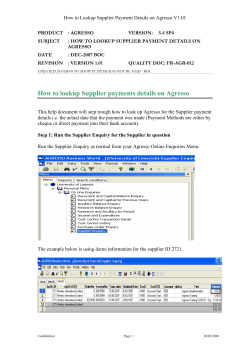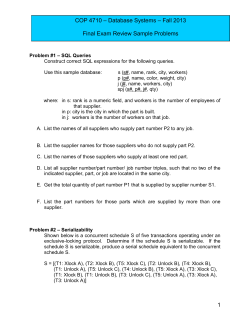
14 Reasons Why Placing a Purchase Order is so Important
14 Reasons Why Placing a Purchase Order is so Important A free whitepaper from Brightpearl outlining the necessity of first-rate order processing. Introduction If you’re a frequently purchasing new stock from vendors and fulfilling multiple orders yourself every day then it is essential that you have a good purchasing process in place. One of the cornerstones of an efficient purchasing process is purchase orders. They give you a record of what has been ordered that is essential for keeping track of your inventory and extremely useful for both forecasting and reporting on many aspects of your business. Remember, you’re not alone... Brightpearl’s business management software, has a team of experts on hand to help you sell more and sell better. Contact us, visit our support portal, or watch our YouTube channel to learn more. Andrew Mulvenna Brightpearl Co-Founder Chris Tanner Brightpearl Co-Founder Purchase order processing is something that a surprising number of small businesses don't do properly. Often it's seen as a hassle or something for the accountant or bookkeeper. Not so! Purchase Order processing is an essential part of any retailer or wholesaler's day to day operations. Even if you place orders on the phone (it’s nice to talk to the lovely salesperson at the other end), or using your supplier’s B2B portal, it’s important to also enter it into your system for a number of reasons. Here’s why: 1. Show goods ordered but not delivered Once your system has the Purchase Order (PO) stored, you and your team have instant visibility of incoming stock; how much is coming and when is it due to turn up. Placing POs at the time of ordering goods is essential. It's no good creating a PO in arrears as soon as the goods turn up at the door! 2. See financial commitment that is not accounted for If you’ve placed a PO with a supplier and they have either started to manufacture, or have shipped the goods, then you most likely have an obligation to pay at some point, even though your accounts don’t yet show a Purchase Invoice. This is important when producing the Year End accounts and Auditors often require it. A properly managed Purchase Order system will quickly tell you what’s been ordered, what’s been shipped, what’s been received but not invoiced and so on. 3. Empower your sales team with information Display PO information to sales people when they are checking stock levels. Then if you’ve run out of something, but they can see that 100 more are due to arrive tomorrow, they will be more confident taking the sale. It’s important to manage your POs with accurate delivery dates for this reason. 4. Prevent over-purchasing Creating POs in the system will help prevent ordering more of an item than you may need, especially if you are working with a supplier that’s unreliable, or if you place frequent overlapping orders with a supplier because the goods already on Purchase Orders are taken into account on the 'Low stock report'. If items are on a PO, you can easily see the “on order” figure in your order processing system. 5. Match Goods delivered against what was ordered The team or individual that receives goods into stock when shipments arrive may well not be the same person that placed the order. If you’re only placing orders on the phone and not using Purchase Orders, then nobody really knows what you asked for. It may be a long time before you realise that the urgent order for 100 toasters only contained 80 - and that the customer that wanted them is not going to know until it’s too late. If your goods-in team know what you ordered, then they can quickly get in touch with the supplier if there are missing items, or incorrect items. Many suppliers require you to notify them of incorrect deliveries within 24 hours - which is easy to spot if you can cross-reference the supplier delivery note with the Purchase Order. 6. Manage goods that have been delivered but not invoiced If you’ve had deliveries of goods that have not yet been invoiced, you have a financial commitment that needs to be accounted for. Not all Purchase Order processing software will account for this, as it’s really accounting information. Fully integrated PO management software can handle this by putting the value of the stock onto a “stock transit code” - so you can easily see at any time the value of inventory you have in your warehouse for which you’ve not yet received a Purchase Invoice. If you just use manual stock corrections to receive goods-in, then you don’t have this information. You can see the value in the Balance Sheet under “Stock received not invoiced”: For full details of Purchase Order accounting, have a look at our documentation or the YouTube video. 7. Purchase Invoice matching and reconciliation When you placed the order for the goods, you were either quoted a price, or were working off a price list sent to you by the supplier at an earlier date. If you send a PDF Purchase Order to the supplier at time of order containing the prices, then there will be no ambiguity as to what the invoice value should be. If your supplier later sends you an invoice for a different value, you will spot it straight away when you receive the Purchase Invoice against the Purchase Order. It’s also common for a supplier with inferior systems to send you an invoice for items that never turned up, or perhaps the wrong model. You’ll be able to take this up with them quickly and clearly when you can present the original Purchase Order PDF that was sent. 8. Maintain accurate cost of sales data “Cost of Sale” is an accounting term that is managed through your 5xxx nominal codes, and appears on your Profit and Loss report. Revenue less Cost of Sale gives you Gross Profit. In a fully integrated system, Cost of Sale information is taken from the actual value of goods shipped to the customer, using First-In-First-Out (FIFO) valuation. The value of goods comes from the value on the Purchase Order, or, on a stock correction without a Purchase Order, the value you have put into the default cost price for the product. If you use Purchase Orders to add inventory, any changes to item values between receiving goods and receiving invoices are automatically accounted for, so your Cost of Sales will be spot on. If you’re not using Purchase Orders to receive goods then your cost price list values are quite possibly of date, since inventory added by stock correction is never reconciled against a Purchase Invoice. Sound complicated? Well yes, it is, but that’s why having a solid system to manage costs and accounting for inventory is so useful. Without a tightly controlled system and processes, you can only generate accurate cost of sale data for your Profit and Loss report after a stocktake, which at best happens once a month. With your Purchase Orders and your Accounting in the same place, your Profit and Loss Report is always up to date. The time you save later is more than offset by the time you spend getting Purchase Orders and inventory values correct. It’s quite often cheaper time, too - would you rather be paying your accountant or your warehouse manager to be sorting out problems? Read more about Cost of Sales and accounting for inventory 9. Control back-order items due from Suppliers In many cases your supplier won’t be able to send you all the goods you asked for in one go. No problem. If you’re managing your supply chain using Purchase Orders, then you (or anyone else in your team - hey, you’ve got other important stuff to do) can easily track what has been received and what hasn’t been. You can make a daily check on anything that’s outstanding and hound the supplier to send you those last toasters that didn’t come in the first shipment! 10. See purchasing history with suppliers Using Purchase Orders gives you a trail of invaluable information about your purchasing and cost cycles. Next time you have a meeting with a supplier to negotiate a discount or place a purchase order for the next season’s goods, you can go armed with the knowledge of exactly what you bought last year, what lines sold well, what you paid for them and how fast the supplier managed to deliver to you. If you ever have to go back and query a troublesome delivery, or check the tracking reference for a shipment, you should be able to find the information on the Purchase Order history. 11. See product pricing history A Purchase Order Detail report will give you line-by-line information as to what you’ve bought in any period, from a certain brand, supplier or product line. You’ll also get the prices that you paid for the items. Lots of valuable information in here can be used to ascertain which items are becoming prohibitively expensive, or even just to get more visibility on what your inventory is costing you. 12. See who you have bought a particular item from in the past If you’ve got tens of thousands of SKUs, or even new staff, information stored in the Purchase Order system will be invaluable when trying to find out where an item can be supplied from. You may not have assigned a product to a supplier, but if you manage your Purchase Order process carefully then it’s easy to have a look at the Inventory Audit Trail for an item (or the Purchase Order Detail report) to see who you’ve bought something from in the past. 13. Print barcodes at the same time as goods-in process Putting barcode labels on your products makes it faster to process sales at Point of Sale (or your warehouse counter), and reduces errors - as long as you get the right label on the right product! Keeping on top of label printing can be a daunting task if your products don’t already come with barcodes on. The best time to put a barcode on your products is when the goods first arrive in your business, which is the same process as a Purchase Order Goods-In. This is also the point at which your system can see exactly how many products have just arrived, in order to print the right number of barcodes. 14. Delegate. Allow your team to grow. Last, but perhaps most importantly, you need to make sure that your purchase information is stored in a system that can be shared amongst others in your business. Many companies rely on just one person to place orders, since all purchasing information is in that person’s head. That’s bad news. Amazing though your staff are, people make mistakes. A collaborative system lets people keep an eye on each other to stop things falling through the net. It lets you share responsibility when someone is ill or on vacation. Sometimes it might feel like you’re doing extra work by placing Purchase Orders, but the benefits easily outweigh the time taken. It’s easy to get started, and of course Purchase Order processing comes as standard with every Brightpearl account. About Brightpearl Brightpearl is a web-based business management system for growing online retailers comprising powerful order processing, inventory management, CRM, multichannel ecommerce software and accounting built in. Everything runs off the same system, which means that you spend less time on admin and more time on growing your business. Visit Brightpearl today for a 30 day FREE Trial: http://www.brightpearl.com
© Copyright 2025
